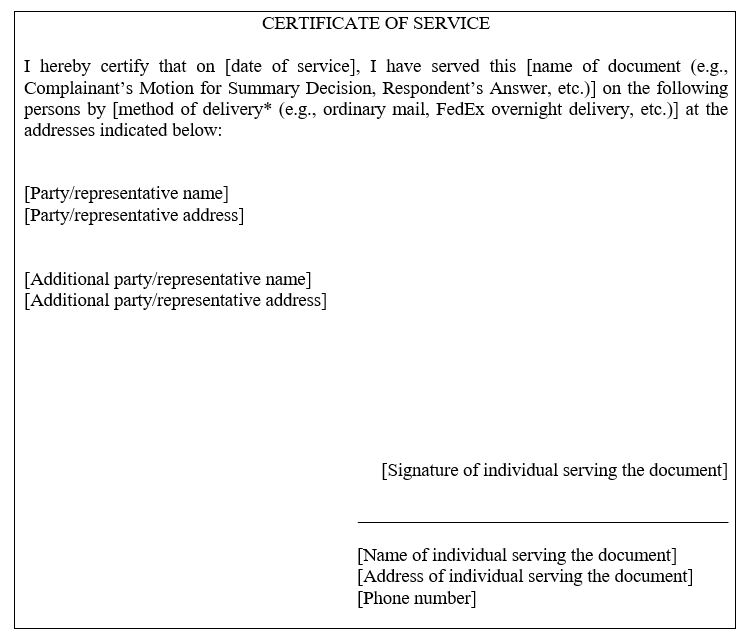Appendix F - Cert. of Service
(a) Overview
All submissions regarding proceedings before the immigration court and the BIA, as well as all submissions to OCAHO (other than the complaint), must include a “certificate of service” (or “proof of service”). See ICPM, Chapter 3.2 (Service on the Opposing Party); BIA PM, Chapter 3.2 (Service); and OCAHO PM, Chapter 3.2 (Filing and service of All Other Pleadings). This Appendix provides guidelines on how to satisfy this requirement.
(b) Requirements
To satisfy the requirement to include a certificate of service, the filing party must do both of the following:
(1) Serve the opposing party
(A) If both parties are participating in ECAS, then no separate service on the opposing party is required for documents electronically filed through ECAS in cases eligible for electronic filing. However, the parties should continue to include a certificate of service in filings that states, “This document was electronically filed through ECAS and both parties are participating in ECAS. Therefore, no separate service was completed.”
(B) In all other scenarios, every time a party files a submission, the party must give, or “serve,” a copy of the filing on the opposing party. If the filing party is a noncitizen in proceedings, the opposing party is DHS. If the case is filed by an individual before OCAHO, the opposing party is the employer. If the employer is represented by an attorney, the attorney must be served with a copy of each filing with OCAHO.
(2) Give the immigration court, the BIA, or OCAHO a completed Proof of Service (or certificate of service for cases before OCAHO). The filing party must submit a signed “proof of service” (or certificate of service for cases before OCAHO) along with the party’s document(s). The proof of service (or certificate of service for cases before OCAHO) tells the immigration court/the BIA/OCAHO that the filing party has given a copy of the document(s) to the opposing party.
(c) Sample Certificate of Service
The parties do not have to use the samples contained in this Appendix. The filing party may write up their own certificate of service or certificate of service. However, these samples will satisfy the proof of service/certificate of service requirement if they are properly completed.
(d) Sending the Certificate of Service
Whenever a party has to supply a certificate of service, it should be stapled or otherwise attached at the end of the document(s) that the party is serving.
(e) Forms that Contain a Certificate of Service
Some forms, such as the Application for Cancellation of Removal for Certain Permanent Residents (Form EOIR-42A) or the Notice of Appeal (EOIR-26), contain a certificate of service, which functions as a proof of service for the form. The filing party must complete the certificate of service to satisfy the proof of service requirement for that form. Such a certificate of service only functions as a proof of service for the form on which it appears, not for any supporting documents that are filed with the form. If the filing party includes supporting documents with a form that contains a certificate of service, the party must file a separate proof of service for those documents.
(f) Forms Filed before the Immigration Court or BIA that Do Not Contain a Certificate of Service
Forms that do not contain a certificate of service are treated like any other document. Therefore, the filing party must supply the certificate of service for those forms when filing before the immigration court or the BIA.
(g) Sample Certificate of Service for Filings before the Immigration Court or the BIA

(h) Sample certificate of service for filing before OCAHO
All OCAHO pleadings and briefs, except for the complaint, must be filed with a certificate of service.

*Please note that the method of service used to deliver a particular filing must be the same for all parties served except where otherwise permitted by regulation.

 U.S. Department
of Justice
U.S. Department
of Justice